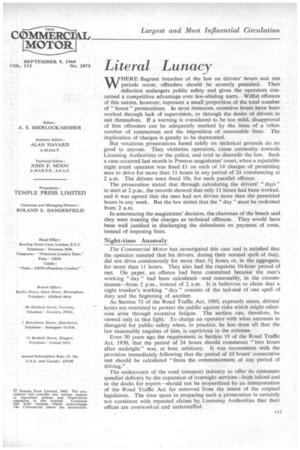Literal Lunacy
Page 49

Page 50

If you've noticed an error in this article please click here to report it so we can fix it.
WHERE flagrant breaches of the law on drivers' hours and rest periods occur, offenders should be severely punished. Their defection endangers public safety and gives the operators concerned a competitive advantage over law-abiding users. Wilful offences of this nature, however, represent a small proportion of the total number of " hours " prosecutions. in most instances, excessive hours have been worked through lack of supervision, or through the desire of drivers to suit themselves. If a warning is considered to be too mild, disapproval of first offenders can be adequately marked by the issue of a token number of summonses and the imposition of reasonable fines. The duplication of charges is greatly to be deprecated.
But vexatious prosecutions based solely on technical grounds do no good to anyone. They victimize operators, cause animosity towards Licensing Authorities or the police, and tend to discredit the law. Such a case occurred last month in Preston magistrates' court, when a reputable night trunk operator was fined fl on each of 14 charges of permitting men to drive for more than 11 hours in any period of 24 commencing at 2 a.m. The drivers were fined 10s. for each parallel offence.
The prosecution stated that through calculating the drivers' " days " to start at 2 p.m., the records showed that only 11 hours had been worked, and it was agreed that the men had not driven more than the permitted hours in any week. But the law stated that the " day " must be reckoned from 2 a.m.
In announcing the magistrates' decision, the chairman of the bench said they were treating the charges as technical offences. They would have been well justified in discharging the defendants on payment of costs, instead of imposing fines.
Night-time Anomaly
The Commercial Motor has investigated this case and is satisfied that the operator ,ensured that his drivers, during their normal spell of duty, did not drive continuously for more than 51 hours or, in the aggregate, for more than 11 hours. They also had the requisite 10-hour period of rest. On paper, an offence had been committed because the men's working " day " had been calculated—and reasonably, in the circumstances—from 2 p.m., instead of 2 a.m. It is ludicrous to claim that a night trunker's working " day " consists of the tail-end of one spell of duty and the beginning of another.
As Section 73 of the Road Traffic Act, 1960, expressly states, drivers' hours are restricted to protect the public against risks which might otherwise arise through excessive fatigue. The section can, therefore, be viewed only in that light. To charge an operator with what amounts to disregard for public safety when, in practice, he has done all that the law reasonably requires of him, is capricious in the extreme.
Even 30 years ago the requirement in Section 19 of the Road Traffic Act, 1930, that the period of 24 hours should commence "two hours after midnight" was, at best, arbitrary. It was inconsistent with the provision immediately following that the period of 10 hours' consecutive rest should be calculated "from the commencement of any period of driving."
The endeavours of the road transport industry to offer its customers speedier delivery by the expansion of overnight services—both inland and to the docks for export—should not be jeopardized by an interpretation of the Road Traffic Act far removed from the intent of the original legislators. The time spent in preparing such a prosecution is certainly not consistent with repeated claims by Licensing Authorities that their offices are overworked and understaffed.
Packed Power
THE application of a power pack to the rear axle of a new rigid eight-wheeled tanker of integral aluminium construction may have created an important precedent. Admittedly, this position was chosen because no suitable pack for mounting at the front was available. Front-wheel drive, with the engine in the cab, could equally well have been employed without sacrifice of payload area. It is, however, the principle of the power pack, already adopted in passenger transport, that has significant possibilities.
Elimination of drive shafts from the main loadcarrying area can be exploited in some applications to increase the load space available at a low level. A power pack also enables unladen weight to be appreciably reduced and the engine can easily be withdrawn for maintenance or overhaul. Of more general interest, however, is the facility with which a power pack and standard running gear can be incorporated in special types of vehicle. Many bodybuilders are fully qualified by their engineering experience to apply them to vehicles of their own design.
Cheaper Aluminium Construction Authorities on light-alloy fabrication say that a power pack gives increased scope for integral construction of rigid vehicles. Latest advances in welding techniques and in the production of sheet aluminium give promise that shortly the overall cost of employing this metal will be substantially reduced. The ease with which large aluminium sections can be handled is a favourable factor in small-scale production and changes can be made to an all-welded light-alloy structure without undue complication.
An efficient hydrostatic system having a pump and independent motors would afford all the advantages of a power pack and give greater flexibility in design. The power unit could be placed in any position and the drive transmitted through pipes to any of the axles without the use of shafts or gear trains.




















































































































































